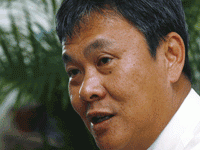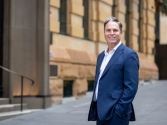
Interview with Jackson Yap
Jackson Yap, CEO of United Engineers, speaks about UE Square.
Q. What do you see as being the key businesses of United Engineers?
We’re an engineering company in the sense that we have core skills in mechanical, civil and electrical engineering as well as project management. We traditionally use these skills in the area of property. And when I say property, we are involved in the value chain of property, which includes design, building and operation. We can also apply these skills in the world of environmental engineering. On the property side, we can be a developer or we can build for you as a contractor or we can be a facility manager to help you manage and maintain the building upon its completion.
Now in the environmental world, our emphasis is on water although we do a little bit of medical waste management as well. Our emphasis is on what we call water engineering which includes drinking water and wastewater, and we can treat wastewater for either disposal or recovery.
Q. What plans do you have for the expansion of UEL’s water engineering and property sectors?
On the water side we want to grow it faster. In the past we used to add scale by doing more organic growtho we would find a new project, grow it, build it and then get it running. This is a slow process, so we want to grow it faster. Two to three years ago it wasn’t a good time to buy because people were asking for the world, but now if you look at the valuations, they have all come down and are more manageable than at peak levels. Now we will probably try to buy something because it is at more reachable levels, so we hope to get some good buys. There are many more opportunities now than there were a couple of years ago. So in the next couple of years we will try to grow that way and build-up our water portfolio.
Q. So what projects does UEL have in the pipeline?
We have two big projects coming up on the horizon including the Gardens on the Bay project for which has enclosed air-conditioning and lighting. And there is also a huge project by City Developments on Beach Road opposite Raffles Hotel.
Q. Who do you see as UEL’s major competitor for engineering contracts?
China is our biggest competitor. There are other Singaporean competitors out there, but the A1 contractors are down quite a lot now because a lot of them have been knocked out over the years. We are competing with the Koreans, Japanese and Chinese and now the Indians are coming to Singapore. Singapore has a very open policy, it’s not like some countries which protect their local contractors.
Q. UEL has been contracted by Korean company Ssangyong for its services at Marina Bay Sands IR. So what exactly is UEL doing at the IR?
We are only doing the electrical package there. Of course we were interested to have done other things, but the civil side is too big for us. So we stayed away from that. At that point of time the demand for materials and all these kinds of things was high, so we preferred to concentrate on the smaller projects which we thought we could better manage and get better margins. UEL has been contracted to deliver the air-conditioning package valued at S$85 million. I think in terms of electrical packages it is probably the biggest so far in a single package. We are also delivering the electrical package at ION Orchard on Orchard Turn.
Q. Analysts said last year that UEL is going to sell off the rest of UE square, so what do you have to say about that?
There are two schools of thought here. As a businessman, I’ve always said that if the price is right, I will sell it. There’s always a price. But some people are more sentimental, and UE square has been here for almost 100 years. In 2012 we celebrate our 100th anniversary and some people are saying, ‘How can you sell our heritage?’ So maybe there are other ways to extract value for shareholders; and perhaps one way is to start our own REIT instead of selling it to another REIT. We have several options.
Q. At One North, you incurred a considerable amount of development expenditure, what happened?
One North is the Rochester project. We bought the land, so we had to pay for it. At The Rochester we never said how much the land was worth, we just let people guess. At the time of its announcment, the total development cost was S$352 million. For Singapore, the land cost is about 50 to 60 percent of the total. Of course, land as a percentage of the total project has now gone up.
Q. There was a serious accident at the Fusionopolis building back in 2004 where according to the MOM, a steel latticework collapsed causing injury to 29 people and the deaths of two. So what was the eventual outcome for UEL from this accident and how has UEL changed its approach to safety since then?
We pleaded guilty to the charge and since then we have done a lot of things internally to address safety management in the company, instead of leaving safety management to the side. In the past we used to run the safety management programs out of the operating units. Now on top of that we have introduced a safety position at the headquarters level to monitor and to also implement a more consistent program throughout the company.
We have a safety, health and environment department at our headquarters, where we work with the operating units to set up a more consistent program. We’ve done a lot since the incident, and our emphasis is really on training and development. We spend a lot of time on training, we’ve got to regroup our management system. We also try to work with our subcontractors and introduce programs to them, so we follow the Safety Council and Ministry of Manpower guidelines, where we try to move the safety level of the subcontractor up the chain. And we have to make sure our own guys are tuned in to the latest safety regulations and certifications as well.
Q. UEL’s profits grew to S$32 million in the 2008 financial year, so why did your before-tax profits drop 91 percent in the second half of 2008?
I think it’s one of the effects of the Yongnam adjustment which was recognised in the previous year. And last year we took in the profit contribution from the Anhui Hefei United Power Generation Company power plant.
Q. What was the reason behind your earnings per share dropping so significantly from 12.2 to 3.9 in 2008?
Part of it was because of the adjustment. I think the other reason was that in 2007 we sold 29,000,000 of our shares in Yongnam Holdings for S$11,999,000. But this year we don’t have anything like that. It was a big drop. I think our earnings are going to be very much determined by our project at the Rochester because if we recognise profits, it will be good for our earnings.
Q. The revenue for UEL’s integrated facility management division was boosted quite significantly in the second half of 2008, due to high rental rates and the sale of the Rochester. So why did your construction and engineering division revenue drop by 8.6 percent in the same quarter?
At that time we were more selective in taking on additional engineering and construction projects as material prices were extremely high and there was a considerable amount of pressure on building equipment.
























 Advertise
Advertise









